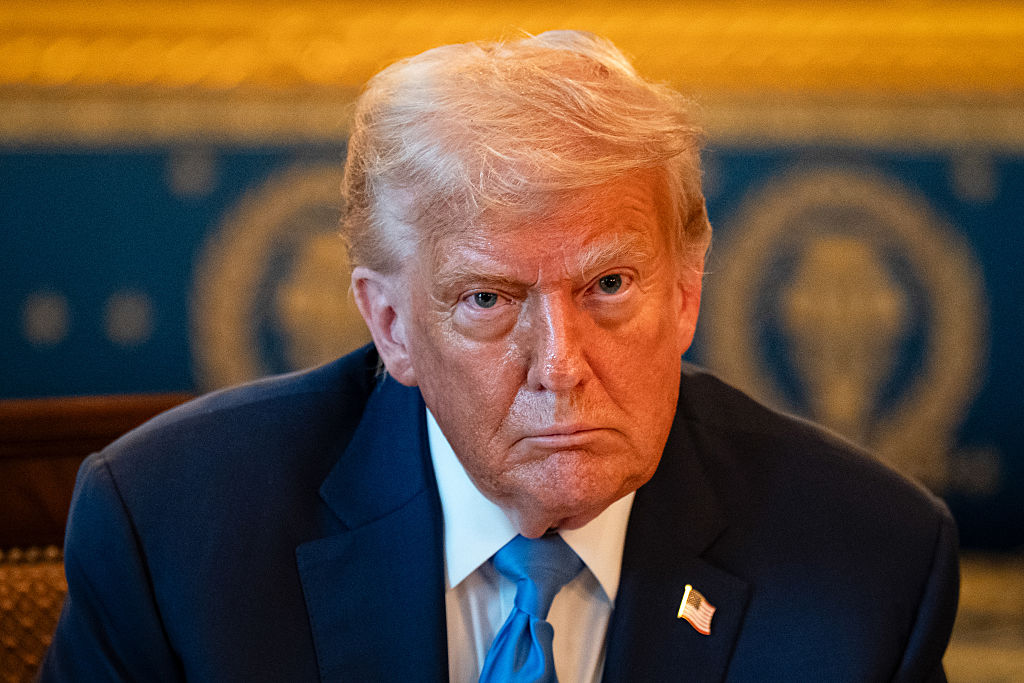Trump delays Liberation Day 2.0, but threatens new tariffs
Donald Trump has extended his 90-day tariff pause but has sent letters to 14 countries detailing the tariffs they will face from 1 August, as well as threatening new levies on copper and pharmaceuticals


Donald Trump’s 90-day tariff pause was due to come to an end today (9 July). The idea was that the punitive measures outlined on ‘Liberation Day’ would be reinstated for countries without a trade agreement with the US.
However, on Monday (7 July), the president announced an extension until 1 August. He also said letters had been sent to 14 countries including Japan, South Korea and Thailand, detailing the tariffs they would pay from this date.
Most of the levies are similar to those announced previously, reaching up to 40% for countries like Laos and Myanmar. Thailand will pay 36%, and Japan and South Korea 25%. Trump said the rates could move “upward or downward, depending on our relationship with your country”.
MoneyWeek
Subscribe to MoneyWeek today and get your first six magazine issues absolutely FREE

Sign up to Money Morning
Don't miss the latest investment and personal finances news, market analysis, plus money-saving tips with our free twice-daily newsletter
Don't miss the latest investment and personal finances news, market analysis, plus money-saving tips with our free twice-daily newsletter
On Tuesday (8 July), Trump added that there would be “no extensions” to the new 1 August deadline. He also announced plans to impose a 50% tariff on copper imports and a 200% levy on pharmaceuticals.
Further announcements are expected later today (9 July). “We will be releasing a minimum of 7 Countries having to do with trade, tomorrow morning, with an additional number of Countries being released in the afternoon,” Trump wrote on Truth Social on Tuesday.
An announcement on semiconductor tariffs is also expected soon.
Tariffs beginning on 1 August
Country | Share of US imports | Newly announced tariff |
|---|---|---|
Japan | 4.5% | 25% |
South Korea | 4% | 25% |
Thailand | 1.9% | 36% |
Malaysia | 1.6% | 25% |
Bangladesh | Less than 1% | 35% |
Bosnia & Herzegovina | Less than 1% | 30% |
Cambodia | Less than 1% | 36% |
Indonesia | Less than 1% | 32% |
Kazakhstan | Less than 1% | 25% |
Laos | Less than 1% | 40% |
Myanmar | Less than 1% | 40% |
Serbia | Less than 1% | 35% |
South Africa | Less than 1% | 30% |
Tunisia | Less than 1% | 25% |
Source: White House and BBC.
How have markets responded?
Copper prices surged in the US on Tuesday (8 July), but stock markets have largely shrugged off the latest developments as investors take a wait-and-see approach.
Markets seem to be getting used to Trump’s way of operating. Some of the threats (such as pharmaceutical tariffs) are not new either, meaning investors have already priced in some of the bad news. The Stoxx Europe Total Market Pharmaceuticals Index – a sector index – is down more than 6% so far this year.
Trump’s delay also suggests he is keen to make deals. He previously promised “90 deals in 90 days”, but so far we have only seen trade agreements with the UK and Vietnam, as well as a partial deal with China involving rare-earth metals. His hardball approach hasn’t paid off in the way he might have hoped over the past 90 days.
“The latest delay in enforcing tariffs suggests that Trump would rather make deals than not, and by singling out individual countries such as Japan and South Korea, he is applying pressure to other countries by example,” said John Wyn-Evans, head of market analysis at Rathbones.
Wyn-Evans thinks a repeat of April’s ‘Liberation Day’ sell-off looks unlikely. “Investors tend not to discount the same potential crisis twice and have also resigned themselves to the fact that tariffs are here to stay, however much they might disagree with the principle.”
Will the new tariffs push inflation higher?
Research provider Pantheon Macroeconomics believes the copper tariff will have little impact on the rate of US inflation, but pharmaceutical tariffs could be more meaningful.
“The 50% tariff imposed immediately on all copper imports will boost the average effective tariff rate by a trivial 0.15 percentage points, equivalent to an uplift to the core PCE deflator of just 0.02 percentage points, if fully passed on to consumers,” said Samuel Tombs, Pantheon’s chief US economist.
“A 200% tariff rate on pharmaceuticals would be a much bigger deal, as they account for 8% of total imports. But the president threatened this exorbitant rate after a proposed transition period of at least one year, allowing time for massive stockpiling, which would limit the impact on businesses’ costs and consumer price inflation.”
The country-specific tariffs announced this week are unlikely to have a meaningful impact on inflation either. If you look at the share of US imports that each of the 14 countries have, 10 of them make up less than 1% each.
The two countries with the biggest share are Japan and South Korea, but even tariffs on these two countries aren’t expected to have a significant impact on US inflation.
Imports from Japan and South Korea account for 5% and 4% of total US goods imports respectively. Pantheon calculates that reciprocal tariffs would only apply to 50% of goods imported from Japan and 30% from South Korea, once exemptions and other carveouts (such as separate tariffs on autos) are taken into consideration.
“Accordingly, we estimate that the average effective tariff rate on all US goods imports will rise by just 0.4 percentage points if the 25% reciprocal rate were to be imposed on imports from Japan, and by a mere 0.2 percentage points if imposed on South Korea,” Tombs said.
“That points to tiny uplifts to the core PCE deflator, just 0.04 percentage points and 0.02 percentage points, respectively.”
One announcement that could have a big impact would be higher reciprocal tariffs on the EU. This has not yet been announced, but Trump has previously threatened tariffs of up to 50%, up from a 10% baseline currently. The EU accounts for 10% of all US imports.
“Hiking the reciprocal rate by 40 percentage points would lift the average effective tariff rate by four percentage points and consumer prices by 0.4 percentage points. Nonetheless, we expect a deal with the EU soon, given that the EU stands ready to retaliate and US public and market appetite for more tariffs is limited,” Tombs said.
What can we expect going forward?
If Trump surprises investors with harsher measures than expected and further agreements are not reached before the new 1 August deadline, we could see equity markets drop as markets price in some of the same concerns seen in April. High trade barriers would push up costs for businesses and consumers and weaken the growth outlook.
However, investors are unlikely to be surprised in the same manner as before – and there is also a big question mark over whether Trump would actually do this given how bond markets reacted last time. His tariff announcements prompted a sharp sell-off in longer-dated US Treasuries, with yields spiking as a result.
Experts have put forward several explanations for the sell-off. Hedge funds and leveraged investors may have been forced to sell liquid assets like US Treasuries to raise cash to meet margin calls. Investors may also have sold up in anticipation of a tariff-related inflation spike – bad news for bonds. Alternatively, investors may have reassessed the stability of US Treasuries in light of Trump’s erratic policymaking and decided the risk-reward profile was no longer attractive.
Whatever the reason, the sell-off was enough to frighten the Trump administration into submission last time around. When Treasury yields spike, the cost of US government borrowing goes up. The US currently has $36 trillion in debt, and foreign investors hold a significant proportion of this. If they decide to start dumping Treasuries and yields spike as a result, the US has a problem on its hands.
Speaking at the Investment Association’s annual conference last month, BlackRock’s global chief investment strategist Wei Li suggested that “US debt arithmetic” could keep Trump’s actions relatively contained. “The US cannot afford… to push debt servicing costs to uncontrollably high levels without consequences,” Li said. “Sustainable US debt requires foreign funding. Walking away from the foreign market when debt is that high is not really a solution.”
‘Trump always chickens out’
In recent months, the phrase ‘Trump always chickens out’ – or TACO – has gained traction among Wall Street traders, who have identified a pattern of dramatic policy statements followed by subsequent U-turns.
It is possible we will see something similar this time around as the 1 August deadline approaches – either in the form of another extension or an easing of the initial tariff rates.
Shortly after announcing the new 1 August deadline, Trump said another extension was not on the cards, but if more agreements are struck between now and then (even tentative arrangements as opposed to full-blown trade deals), it could result in an easing of tensions.
In the meantime, investors will turn their attention to the usual drivers of markets – economic data and company earnings.
“The bar is set quite low for US corporate earnings, with just 4% year-on-year growth expected,” said Wyn-Evans.
“Meanwhile, away from the US, there have been some encouraging signs of an upturn in purchasing manager survey readings and increased optimism about the potential for higher growth in Europe as it pursues increased fiscal stimulus, the dismantling of regulatory barriers and more investment in innovation.”
Not everyone is convinced that US exceptionalism is over, though. Global asset management firm BlackRock remains bullish on the US outlook. Its investment institute believes “immutable economic laws” such as the US debt dynamics introduced previously will keep Trump in check.
“We see scope for overall corporate earnings to stay solid even if US growth is dented by tariff-induced disruptions and corporate caution,” its strategists said in a July research note.
Factset estimates published earlier this month suggest the S&P 500 achieved annual earnings growth of 5% in the second quarter. Back in March, analysts had been forecasting 9.4%. If the 5% estimate turns out to be correct, it would mark the lowest level of growth since the fourth quarter of 2023.
Not all analysts are overly concerned, though. “What matters is that growth remains positive and meaningful. A 5% earnings expansion in today’s environment represents a genuine achievement, demonstrating corporate management’s ability to navigate challenges while maintaining profitability,” said Chris Beauchamp, chief market analyst at IG.
Get the latest financial news, insights and expert analysis from our award-winning MoneyWeek team, to help you understand what really matters when it comes to your finances.
Katie has a background in investment writing and is interested in everything to do with personal finance, politics, and investing. She previously worked at MoneyWeek and Invesco.
-
 Metals and AI power emerging markets
Metals and AI power emerging marketsThis year’s big emerging market winners have tended to offer exposure to one of 2025’s two winning trends – AI-focused tech and the global metals rally
-
 8 of the best houses for sale with beautiful fireplaces
8 of the best houses for sale with beautiful fireplacesThe best houses for sale with beautiful fireplaces – from a 15th-century cottage in Kent to a 17th-century palazzo in Oxfordshire
